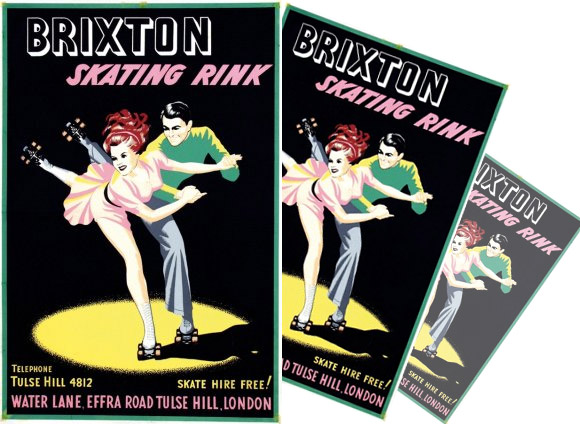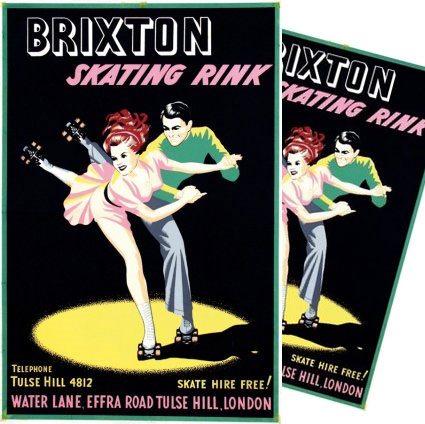
For over half a century Brixton had its own roller skating rink, located on the corner of Effra Road (opposite the George Canning/Hootenanny).
Opening in 1910, contemporary reports say that dance bands regularly played at the skating rink, with a William Robert Fuller (b.1889) being a well known performer there.
Mr Fuller appears to have been a particularly talented chap and was able to play the Trumpet, Cornet, Piano, Organ, Violin, One string fiddle, Mandolin and the Swanee Whistle! (source).
The rink closed around 1965, and was occupied by a carpet warehouse for many years before being converted into a Sainsbury’s supermarket in 2012.
Fred Wilkinson’s excellent account manages to give us a flavour of what we’ve lost:
Fred Wilkinson at Brixton Roller Rink: Figure Skating Class circa 1959 – 1960
Roller skating was a major passion throughout my teens and I went to Brixton Roller Rink as often as possible from the mid 1950s until autumn 1961 when I left home to attend art school.
I loathed most sports, especially ball games and anything demanding teamwork, but self-reliant activities such as judo, rowing, fishing and skating had a much greater appeal. I had my first pair of street skates when I was 6 or 7 and roller skating became the only sport I ever excelled at.
As a teenager I went skating several times a week, and was never happier than racing around the Brixton rink impressing and chatting-up the girls.
My five shillings (25p) pocket money didn’t stretch very far, so I financed my hobby by helping street market traders during the school holidays and at weekends until I reached 14 when I took a part-time job at the rink’s cafe – serving snacks of toast and Mrs Ball’s home-made bread pudding, and ferrying (on skates) cups of tea to customers seated at tables.
This photo above was taken to celebrate a child’s birthday after one of the private dance classes given by the lady teacher on the right. I’ve no idea how I came to have a copy.
I was 15 and could only afford a few lessons, and would have liked more, but the instructor gave the clear impression that I was a little too ‘common’ to be mixing with her middle-class protégées with their proper costumes and expensive figure skates (I wore jeans and my Mum’s hand-knitted sweater, and my pride and joy were my homemade racing skates with wooden wheels and strips of tyre rubber for brakes).
The teacher also disapproved of my interest in the girl whose hand I’m holding…the shy star of her figure skating class! Her younger sister is beside her.
I abandoned my lessons after realizing that skates built for speed lacked the ankle support and toe stops necessary for elegant figure skating and fancy dance manoeuvres. There was no way I could afford a second pair of skates.
I believe the smartly-dressed elderly gentleman in the front row manned the ticket kiosk. He also changed the dreary orchestral records that we skated to, and made announcements on the Tannoy. He was very short, as were several others on the staff. Indeed it seemed almost a pre-requisite of employment to be of diminutive stature.
The lady above him in the middle row also worked at the rink, distributing skates to the ladies. Her brother, an Arthur Askey look-alike with thick-rimmed glasses (not in the photo), distributed skates to the men and then patrolled the rink to ensure good behaviour during public skating sessions.
The tall lady wearing spectacles in the back row was often present and may have been related to a member of staff or the management in some way. All the others were regular members of the figure skating class, none of whom I knew.
A typical skating session would last 3 hours, and a queue would begin to form outside the rink about 20 minutes before opening time. Very few people had their own skates and getting there early meant having the pick of the rink’s skates…or at least getting the correct size.
Once inside you would queue at a counter to collect your strap-on skates, then hand over your coat and bag and pick up a ticket for their return at the end of the session.
If your skates didn’t roll straight and true you would have to join the end of the queue again to exchange them, by which time mainly the duds were left.
Interior view of Brixton Skating Rink showing perimeter seats, tables and lavish use of bunting [ c.1920 © Lambeth Landmark]
The music would start and off you would go…skating clockwise around the rink which would be freshly dusted with French chalk to prevent slipping. After a while there would be an announcement over the loudspeaker and everyone would skate in the reverse direction.
A member of staff was responsible for maintaining orderly behaviour on the rink. He would skate slowly backwards between the oncoming skaters and toot his whistle and admonish anyone who stepped out of line and broke the rules.
Pushing, speeding, skating against the flow and cutting across the rink were major offences. It was forbidden to cut across the rink as the centre was reserved for the more serious skaters to practice forward and backward figures.
Professional skaters
Halfway through the session there would be an interval and the rink would be cleared to make way for professional skaters to demonstrate their skills.
This was when everyone headed to the cafe for a snack and a smoke. Then, if it was an evening or weekend session, members of the Brixton speed skating team would have their turn to tear around the rink as fast as they could.
With the music turned off and so many wooden wheels hitting the deck at speed this was a very noisy affair. They always skated in single file, bent double with right arms swinging and the other neatly folded behind their backs. I was too young to join the team but would occasionally tag onto the end as they tore around the track.
National Anthem
After a dozen or so circuits the MC would clear the floor and the music would start up again in a lighter, more contemporary, vein (Fats Domino, Johnnie Ray, Ray Charles) and it would be time for everyone to return to the rink for a final clockwise session before the National Anthem and home time.
Advertisement published in the Brixton Free Press showing a roller skating couple at the Brixton Rink [© 1914 Lambeth Landmark]


